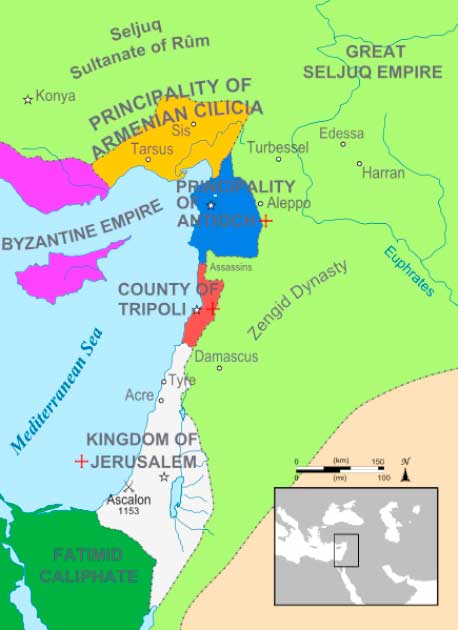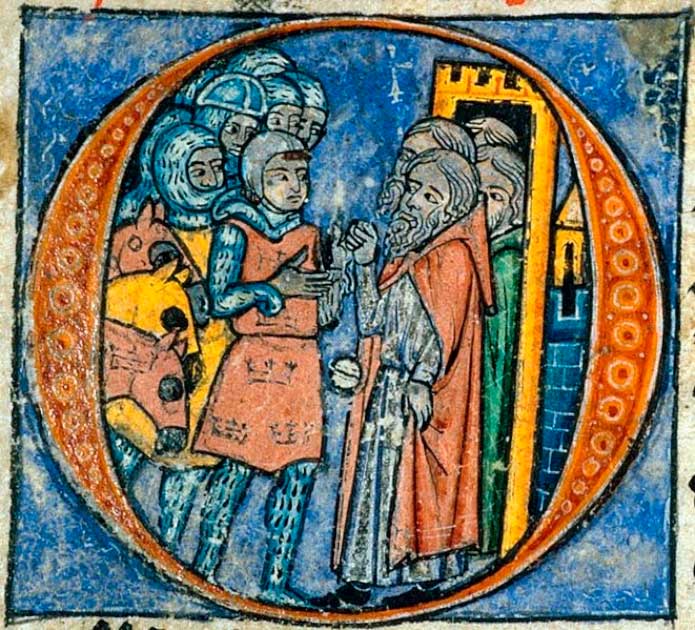The First Crusade, inspired by a Byzantine call to arms in 1095 and legitimized by the Pope the following year, was a brilliant strategy for rearranging European affairs. With the Catholic church stating that sins could be absolved through armed pilgrimage to the Holy Land and Jerusalem, religion was thrust to the forefront of European politics, coloring European policy for the next two centuries.
However, it is not immediately clear that the church, or those who joined the crusade, actually expected to win Jerusalem. The Holy Land had been Muslim for centuries, and to win it all back seemed an almost insurmountable challenge.
But, with God apparently on their side, that is exactly what happened, and in 1099 Jerusalem fell to the crusaders. It seems they were almost as surprised as everyone else that they had won, but this unlikely victory created a new situation. There was now a new Christian kingdom in the Middle East: Outremer.
Actually, technically there were four new Christian kingdoms, collectively named Outremer. Created by the Catholic leaders of the First Crusade in the 1090s, they were the Kingdom of Jerusalem (1099-1291), the County of Edessa (1098-1150), the Principality of Antioch (1098-1287), and the County of Tripoli (1102-1289).
Whilst the area covered here is often referred to as the Crusader States, this is a touch misleading. Few of the people who lived there were “Frankish” like the conquerors. The term Outremer, derived from the French “Ultramar” meaning overseas, was used by medieval writers but has been somewhat forgotten today.
So what was Outremer like? And how did a small band of armed Franks and their followers hold sway over an Arabic population for so long?
The Origins of Outremer
The First Crusade was called by Pope Urban II in 1095 from Clermont where he gave a raucous and inspiring speech. Whilst there is no record of exactly what he said, from nearly contemporary sources, Urban denounced warfare between Christian Kingdoms of the west.

He suggested that they should instead turn their combined attention to the east where the Muslims and Turks had been attacking the Byzantine Empire, a Christian kingdom. Importantly, he offered remission of sins for those who participated in the crusade and won back their rightful Christian territories. The crowd was so enamored that the first chant of the crusades was born: “Dieu li volt” or “God wills it”.
- The Albigensian Crusade: Why did the Catholics start a Civil War?
- Prester John: The Legendary Christian King
Travelers from all across Europe decided to take up arms. From nobles and professional soldiers to camp followers and peasants, all traversed the land to the Byzantine capital of Constantinople. It was the last foothold of Christendom in Eastern Europe and had some of the biggest churches in the world. And in 1096, the main forces of the crusaders began to take the land which later became known as Outremer.
Life in the Crusader States
There was a mix of cultures in the crusader states and as such it could be a tense and difficult place to live. It revolved around the key factors of the economy, religion, and military power. The people who lived there were often a mix of peoples from Europe, the Middle East, and Northern Africa. This was because this area on the eastern coast of the Mediterranean was a trading and religious hub.
The crusader states were located in the center of the Holy Land which granted access to the major trade routes that sprouted to Europe, Africa, and Far East Asia. The Silk Road is one of the most memorable of these, it was one of the earliest and largest trade networks in human history.
Stretching from Japan and China to Italy in the western world, its span in total was over 4,000 miles (6,440 km) crossing different regions and cultures including India, Africa, and eastern Europe. Chinese and Mongol traders used these roads extensively as they gave them access to Europe where they could trade their luxurious exotic gifts that were desired by Europeans.
With such a diverse population, the role of religion was crucial in Crusader society. It was a place of worship and intersection for three of the major religions. Christianity, Judaism, and Islam. This was especially true of the city of Jerusalem.
The city was located in the heart of the Holy Land and the new kingdoms of Outremer, between the Mediterranean and the Dead Sea. It is held in such high regard as it has importance for them all: it was the claimed by the jews as the “promised land” granted to them by God, by the Christians as the site of the crucifixion of Jesus, and by the Muslims as their promised land and the location where Muhammed ascended to heaven.
All three of these religions had holy sites in the city, and there was a surprising degree of tolerance regarding permitting the different religions to observe their holy practices. It seems that the idealism (and opportunism) which had launched the First Crusade had been adapted in the face of the realpolitik of the region. And perhaps this tolerance is why Outremer existed for so long.
A Powerful Military
But there was also a tension to Outremer as these competing ideologies jostled against each other, and due to this tension, the crusader states had a high level of military presence. Outremer became the center point for many different battles, conflicts, and wars across the two centuries of its existence.

Citizens that were living in the states were often called up to fight against the Muslim armies. Thus the crusader states operated in much of the same way that feudal kingdoms in the west did. Under this system, Outremer was ruled by a series of local lords who used serfs, effectively slaves, to act as soldiers in times of conflict and as farmers in times of peace.
- Great Relic of the Israelites: Where is the Ark of the Covenant?
- King John: England’s Most Hated King?
Military life as a day-to-day reality was an ongoing aspect of life for the people of Outremer. The leaders of these states often used their links from back home in Europe to fund their military expeditions and to provide aid when they needed it.
Never a True Kingdom?
Despite being able to build and create settlements in the area, it was never truly settled and is more accurately described as being “occupied”. The crusader states would continue to swap hands regularly over the two centuries that they existed.
The first crusade was followed by the second in 1147 as the first of the four territories of Outremer, the County of Edessa, had fallen to the Turks. However, the Christians experienced crushing defeats in this crusade and failed to make any progress.
The third crusade, perhaps the most well-known, saw Richard the Lionheart of England take the battle to Saladin and reclaim many coastal territories for the crusaders. He was unable to make a crucial victory though, coming within touching distance of Jerusalem but being ultimately unable to take the city.
He did come to a settlement with the Muslims allowing for freedom of religious worship for Christians in Jerusalem, finding himself a realist in the face of the political situation in the region after all. Richard’s absence from England while campaigning in the Holy Land was the inspiration for the legend of Robin Hood, although in truth the king never made it home, being shot by a common archer as he assaulted a French castle on his return.

There were many crusades after this as the territories swapped hands from Christian to Muslim. It was the Ninth Crusade that was the final one. It took place in 1271 but ultimately failed. Many efforts were made to spark another, but they failed to come to fruition.
In 1291, the Muslim forces took the final crusader state of Acre which stopped any further crusades. However, this did not mean that Christians left the area as many stayed to live their life under Muslim rule.
By this point Jerusalem herself had been lost for more than a century. In 1187 after her mighty army was destroyed at the Battle of Hattin, she fell to Saladin of the Ayyubid Sultanate. Outremer had lost her heart.
Yet, for two centuries, Outremer had endured against the attacks of her Muslim neighbors. Through a strong military, through the vocal support of the Catholic Church, and through a degree of religious tolerance, there had once again been a Christian kingdom at Jerusalem.
Top Image: Jerusalem won and a kingdom to run, but what was Outremer actually like? Source: Émile Signol / Public Domain.
By Kurt Readman